Portions of this site and the works within it are beingproduced with the intention of critique and/or educational use under Australia's 'fair dealing'exceptions to copyright (Section 40 & 41). However, if you feel your IP is being infringed, pleasecontact my service provider (tumblr) with the appropriate DMCA requests, as I, the single authortake full responsibility for the content of this site.
Don't wanna be here? Send us removal request.
Text
📱💥 Who Gets to Govern the Feed? Maybe it’s time we did.
Let’s get real about Digital Citizenship & Conflict on Social Media 💥🧠
Do you ever scroll through Twitter or X, ugh 🙄, or TikTok and feel like you’re watching a never-ending battlefield in 4K? One second it’s memes, the next it’s cancel culture, disinformation, bots, and beefs blowing up over literally anything. But beneath all the drama is a deeper question: Who really governs our online spaces, and how are we as users part of it? Let’s break it down.

First off, digital citizenship isn’t just about being polite online or citing your sources in a discussion thread. It’s about how we, as internet users, engage responsibly, ethically, and critically in digital environments. That includes knowing how algorithms shape what we see, recognizing fake news, and understanding power dynamics between platforms, users, and governments (Ribble & Shaaban, 2011).
Conflict online is baked into the system. From culture wars to celebrity takedowns, social platforms amplify outrage because it drives clicks and keeps people engaged. Algorithms often reward conflict over consensus (Tufekci, 2015). Ever noticed how controversial posts get way more traction than calm, nuanced takes? Yeah, that’s not an accident.
But it’s not just interpersonal drama. Think about how protest movements like #BlackLivesMatter or #FreePalestine are policed by platforms, shadowbanned, flagged, or demonetized, while hate speech can fly under the radar if it’s “profitable.” That’s because platform governance isn’t neutral, and moderation is often more about PR and profit than justice (Gillespie, 2018).
👮♀️ So Who’s in Charge?

You’d think the internet is the Wild West, but there are actually layers of governance happening:
• Platform Rules (TOS, community guidelines, algorithmic moderation) • Government Laws (think Malaysia’s MCMC, EU’s DSA, U.S. Section 230) • Community Norms (call-outs, blocklists, meme codes of conduct)
And guess what?
All of these layers can clash. Like when activists get banned for violating “hate speech” policies while calling out actual hate speech. Or when governments use digital laws to crack down on dissent under the guise of “fake news regulation” (Bradshaw et al., 2020).
💬 What Can We Do? (Because We’re Not Helpless)
Being passive won’t cut it anymore. If you’re here on Tumblr, arguably one of the OG digital counterpublics, you already know the value of curating safe spaces, calling out harmful content, and pushing back against exploitative moderation.

So: • 🔹 Educate yourself & others on how algorithms work • 🔹 Amplify marginalized voices & community-led content policies • 🔹 Demand transparency from platforms • 🔹 Organize, because collective action does change policy
Digital citizenship isn’t just about being nice online—
it’s about understanding the systems that shape our digital lives and taking responsibility for how we engage.
Social media platforms aren’t neutral spaces; they’re governed by complex layers of rules, algorithms, and power dynamics. But we have the power to influence these spaces by educating ourselves, holding platforms accountable, and advocating for change.
Let’s work together to make social media a safer and more inclusive space for everyone.
References:
Bradshaw, S. (2020). Industrialized Disinformation 2020 Global Inventory of Organized Social Media Manipulation. Oxford Internet Institute.
Gillespie, T. (2018). Custodians of the internet: Platforms, content moderation, and the hidden decisions that shape social media. Yale University Press.
Ribble, M., & Shaaban, A. (2011). Digital Citizenship in Schools Second Edition. ResearchGate.
Tufekci, Z. (2015). Algorithmic Harms Beyond Facebook and Google: Emergent Challenges of Computational Agency. Colorado Technology Law Journal.
#mda20009#digitalcitizenship#cancelculture#socialmediagovernance#onlineharassment#platformaccountability#freedomofspeech#socialmediaethics
0 notes
Text
🎮 Twitch: From Gaming Platform to Global Community Hub 🌐💜
Hey peapoles! 👾
Remember when Twitch was just a place to watch people play games?

Well, buckle up, because it’s evolved into so much more. Let’s dive into how Twitch has transformed from a gaming-centric platform to a vibrant community space.
Originally launched in 2011 as a spin-off of Justin.tv, Twitch focused primarily on video game streaming. However, over the years, it has expanded its content offerings to include “Just Chatting,” music performances, cooking shows, and even political discussions (Wired, 2019). This diversification reflects a broader trend where platforms are moving beyond their original niches to cater to a wider audience.

Twitch isn’t just about watching content; it’s about engaging with it.
Streamers and viewers interact in real-time through chat, creating a dynamic environment where communities can form and thrive. This interaction fosters a sense of belonging and emotional connection, turning casual viewers into loyal followers (Harris, 2023).

With its expansion, Twitch has also become a platform where creators can monetize their content. Through subscriptions, donations, and sponsorships, streamers can turn their passion into a profession. This shift has empowered many to pursue full-time streaming careers, contributing to the rise of the
“creator economy”
(Kim et al., 2025).
Twitch’s reach isn’t limited to gaming enthusiasts (Lynons, 2022). It’s a platform where people from diverse backgrounds come together to share experiences, support causes, and build meaningful connections. For instance, during events like TwitchCon, creators and fans unite to celebrate their shared interests and contribute to charitable initiatives (as.com).
All in all, Twitch has come a long way from its roots in gaming. It’s now a multifaceted platform where communities are built, creators thrive, and viewers find a sense of belonging. Whether you’re into gaming, music, or just chatting, there’s a space for you on Twitch.
Stay connected, stay kind, and keep streaming! 🎮💜

References:
Harris, B. C. (2023). We’ll do it Live! Unpacking the Community-Building Labor of Twitch Streamers. Retrieved from ResearchGate
Kim, J. E., Ha, S., Kim, S., & Hemphill, L. (2025). The Spread of Virtual Gifting in Live Streaming: The Case of Twitch. Retrieved from arXiv
Twitch’s Non-Gamers Are Finally Having Their Moment. (2019). Wired. Retrieved from Wired
TwitchCon 2025 Highlights. (n.d.). as.com. Retrieved from as.com
#mda20009#twitch#livestreaming#gamingcommunity#digitalcitizenship#creatorculture#gamerlife#parasocialrelationships#twitchstreamer
0 notes
Text
The Filtered Mirror: How Instagram Filters Shape Our Self-Image
“Hey there, fellow filter explorers!” ✨ So, let’s talk about something we all know too well: Instagram filters. You know, the ones that smooth out your skin, make your eyes pop, and give you that “glow-up” in an instant. They’re fun, right? But have you ever stopped to think about

How are these filters changing the way we see ourselves?
Filters have become a staple in our social media routines. They promise to enhance our features, making us look more polished and, dare I say, perfect. But here’s the catch: these filters often present an idealized version of beauty that doesn’t reflect reality. This phenomenon has been termed “digitized dysmorphia,” a concept introduced by Coy-Dibley (2016), which describes the distortion of self-perception due to the prevalence of digitally altered images. While filters can boost confidence temporarily, they can also lead to negative consequences.
Research indicates that frequent use of beauty filters on platforms like Instagram can contribute to body dissatisfaction and lower self-esteem, particularly among young women (Barker, 2020).
The constant comparison to these enhanced images can create a gap between our real selves and the filtered versions we present online.

The pressure to conform to these digital beauty standards is real.
A study by Lo Destro (2024) found that individuals with lower self-esteem or those who are more susceptible to external opinions are more likely to place greater importance on using filters.
This can lead to a cycle where the desire for validation through filtered images outweighs the appreciation of one’s natural appearance.
So, what does this mean for us as digital citizens? It means being aware of how filters influence our self-perception and the perceptions of others. It’s about recognizing that while filters can be fun and creative tools, they shouldn’t define our worth or beauty. Embracing authenticity and promoting a culture of self-acceptance online can help mitigate the negative impacts of these digital enhancements.
In Conclusion 🔚
Instagram filters are more than just tools for enhancing photos; they are shaping our digital identities and influencing our self-image. As we navigate this digital landscape, let’s strive for authenticity and self-love, remembering that the real beauty lies in our unfiltered selves.

References:
Barker, J. W. (2020). Making-up on mobile: The pretty filters and ugly implications of Snapchat. Fashion, Style & Popular Culture, 7(2 & 3), 207-223.
Coy-Dibley, I. (2016). “Digitized Dysmorphia” of the female body: The re/disfigurement of the image. Palgrave Communications, 2(1).
Lo Destro, C. (2024). Unraveling the impact of self-esteem on the utilization of Instagram filters: The mediating role of fear of negative evaluation. Frontiers in Psychology, 15, 1302662.
#InstagramFilters#DigitalCitizenship#BodyImage#MentalHealth#SocialMedia#SelfExpression#ARFilters#DigitalIdentity#BeautyStandards#SelfEsteem#BodyDysmorphia#mda20009
0 notes
Text
“Body Mods, Beauty Standards, and the Battle for Authenticity on Social Media”
Hey besties 🌐✨
Let’s talk about body mods. And it’s not just piercings, tattoos, or some girl who went and actually got her tongue split, but how they’re framed, flexed, and fetishized on visual social media platforms like Instagram and TikTok.
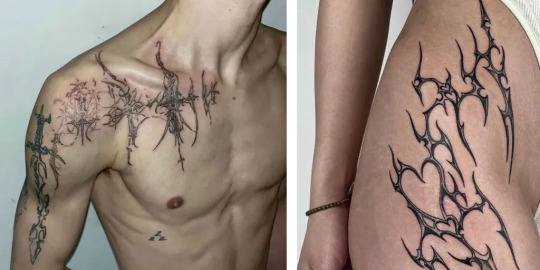
For Gen Z, the body isn’t just a site of identity; for them, it’s more of a content.
And in the age of selfies and scrolling, platforms have become stages for modified bodies to gain visibility, validation, and sometimes, to get it viral. This isn’t inherently bad, many of us finally have spaces to showcase our authentic selves, especially queer, trans, and neurodivergent folks who’ve historically been erased in mainstream beauty discourses (Pitts-Taylor, 2007). But, there’s still a catch: social media algorithms and aesthetics often reward certain kinds of bodies, modifications, and performances. Let’s take a look at that.
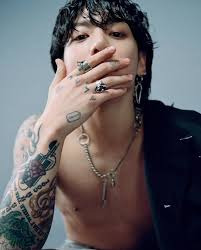
Take Jungkook of BTS, for example, an icon not just in K-pop but in global pop culture. His visible tattoos, piercings, and even eyebrow slits challenge the “idol” aesthetic historically promoted in the Korean entertainment industry. While Jungkook receives massive support online, his body mods still spark intense debate and scrutiny, especially in South Korean media. It’s a perfect example of what Marwick (2015) describes as “micro-celebrity” culture, where the personal becomes public property, and self-expression gets tangled with image control and audience perception. Jungkook’s modifications have made him a symbol of rebellion and self-ownership, but also a target of hyper-visibility and critique.
And this isn’t just about celebs.
Modified bodies on Instagram or TikTok, whether pierced, tattooed, or surgically enhanced, are often filtered through aesthetic capitalism. As Featherstone (2010) argues, bodies have become “a form of capital,” with modification serving as investment in one’s online persona. Mods that align with Eurocentric beauty ideals, small noses, pouty lips, and smooth skin tend to attract more attention on the algorithm. We stan expression, but not when it’s commodified by capitalist filters.

It is crucial to recognize the racialized power dynamics inherent in online representations of body modification. While white influencers who adopt body modifications are frequently valorized as “edgy” or “avant-garde,” Black and Brown creators often encounter exoticization, stereotyping, or even censorship for similar expressions of identity (Davis, 1995). The algorithms underpinning visual social media platforms are far from neutral; they perpetuate and amplify structural inequalities under the veneer of aesthetic trends.
However, counter-narratives are emerging within digital subcultures. Communities in TikTok’s alternative spheres, queer-centric Instagram spaces, and K-pop fandoms, particularly those celebrating idols like Jungkook, are actively redefining the discourse around body modification. These digital counterpublics illustrate how body modification can function as an act of cultural reclamation, emotional fortitude, and subversive empowerment.

Ultimately, though body modification remains enmeshed in debates around visibility, performativity, and algorithmic commodification, it should not be reduced to a mere instrument for digital validation. Authentic self-expression through bodily autonomy must transcend the confines of engagement metrics and platform-driven aesthetics. References:
Davis, K. (1995). Reshaping the female body: The dilemma of cosmetic surgery. Routledge.
Featherstone, M. (2010). Body, image and affect in consumer culture. Body & Society, 16(1), 193–221. https://doi.org/10.1177/1357034x09354357
Marwick, A.E. (2015). Instafame: Luxury selfies in the attention economy. Public Culture, 27(1), 137–160. https://doi.org/10.1215/08992363-2798379
Pitts-Taylor, V. (2007). Surgery junkies: Wellness and pathologies of cosmetic surgery. Rutgers University Press.
1 note
·
View note
Text
🌿 Lululemon & the Illusion of Ethical Style: Are We Being Greenwashed? 🌿
Let’s chat about something I’ve been thinking a lot about: Lululemon. You know, the “live your best life in leggings” brand that seems to scream wellness, sustainability, and good vibes. But… is Lululemon really as ethical as it looks? Or are we being greenwashed into spending $120 on yoga pants? 👀
✨ What’s the Deal with Lululemon?
Lululemon’s whole vibe is about conscious consumerism—they market themselves as a brand that cares about quality, sustainability, and community. They use buzzwords like eco-friendly materials and fair wages, and they’ve built a massive influencer army of “Lululemon Ambassadors”—yoga teachers, fitness influencers, and lifestyle creators who promote the brand’s feel-good message across Instagram, TikTok, and YouTube.

But here’s the thing: according to Greenpeace (2022), Lululemon’s supply chain has been linked to environmental issues like water pollution and synthetic textile waste. And they’ve faced labor rights criticisms, especially in factories producing their leggings in countries like Bangladesh and Cambodia. So… where’s the line between sustainable fashion and greenwashed marketing?

🎥 How Influencers Shape Our Perceptions
This is where digital citizenship comes in. As consumers in the digital world, we’re bombarded with posts like “Lululemon haul! #GRWM” and “My fave leggings for hot yoga!”—all selling an aesthetic of mindful living. But are these influencers helping us make informed choices? Or are they unintentionally amplifying a culture of overconsumption?
Influencers like Venetia La Manna and other sustainable fashion advocates use their platforms to raise awareness about the realities of fast fashion, including the environmental and ethical issues behind brands like Lululemon. And the truth is, greenwashing is everywhere—according to Naderer & Opree (2021), brands can manipulate consumers by appearing eco-conscious without real systemic change.

🧘♀️ What Can We Do as Digital Citizens?
It’s all about critical engagement. When you see a cute Lululemon post, ask:
✅ Is this brand truly sustainable?
✅ What’s the real environmental impact?
✅ Am I buying something I need, or just chasing a trend?
The #WhoMadeMyClothes movement reminds us to look beyond the logo and ask questions about labor conditions, materials, and environmental impact.

🌿 TL;DR: Mindful Consumerism is a Vibe 🌿
Lululemon looks sustainable, but the reality is complicated. As digital citizens, we can’t just scroll and shop—we need to stay critical, ask questions, and support genuinely ethical brands. Sometimes the most sustainable outfit is the one you already own.
So next time you see a Lululemon ad or influencer post, maybe pause and ask: Do I really need it? Or is it just clever marketing in a $120 pair of leggings?
Let me know your thoughts! Do you think Lululemon is the real deal or a wellness greenwash? Drop a comment below! 🌿✨
References
Greenpeace 2022, Greenwashing in the Apparel Industry, viewed 15 May 2025, https://www.greenpeace.org/international/story/greenwashing-fashion.
Naderer, B. & Opree, S.J. 2021, Increasing Advertising Literacy to Unveil Disinformation in Green Advertising, Environmental Communication, vol. 15, no. 7, pp. 923–936.
Fashion Revolution 2022, Who Made My Clothes?, viewed 15 May 2025, https://www.fashionrevolution.org/.
Vito, F. 2022, What Is Slow Fashion and How Can You Join the Movement?, Earth.org, viewed 15 May 2025, https://earth.org/what-is-slow-fashion/.
#MDA20009#Lululemon#Greenwashing#SustainableFashion#SlowFashion#DigitalCitizenship#WellnessCulture#EthicalFashion
0 notes
Text
What TikTok’s Algorithm Taught Me About Digital Citizenship 😬
Scrolling through TikTok, I often find myself got lost in a mix of content 😵💫—from dance challenges to political debates. Then, I stumbled upon a series of videos under the hashtag #FreePalestine. Ranging from personal testimonies to protest footage,
it opened my eyes 👀
to the platform’s power in shaping political discourse. This led me to reflect on the concept of digital citizenship and how platforms like TikTok influence our engagement with global issues. 🤔

Being a good digital citizen means using technology in a responsible and ethical way 🙂↕️.

According to Ribble (2008), it involves understanding the norms of appropriate behaviour concerning technology use, including digital etiquette, literacy, and rights and responsibilities.
In today’s interconnected world, being a good digital citizen means critically evaluating online content, engaging respectfully, and contributing positively to digital communities.
With the emergence of hashtags, it has revolutionised how we engage with social movements online. Nathan Rambukkana (2015) describes “hashtag publics” as temporary, discursive communities formed around shared hashtags, enabling collective action and discourse. On TikTok, hashtags such as #FreePalestine have rallied users globally, promoting awareness and unity.
TikTok’s algorithm curates content based on user interactions, boosting existing beliefs. While this personalisation enhances user experience, it also poses challenges for digital citizenship. For instance, during the 2024 U.S. presidential election, research indicated that TikTok’s algorithm favoured content that aligned with Republican perspectives, which could impact political views (Ibrahim et al., 2025).
Rapid spread of content on TikTok = the spread of misinformation

A BBC investigation indicates that users were exposed to fake AI-generated videos showing political leaders within minutes of joining the platform (BBC News, 2024). This highlights the importance of critical evaluation and media understanding as a responsible digital citizen.
My experience with activism and knowledge on TikTok has made me realise how important it is to be a good digital citizen. As individuals engaging with these platforms, it’s essential to approach them thoughtfully, acknowledging the impact of algorithms and the risks of misinformation. Through responsible and thoughtful engagement, we can help foster a more informed and ethical digital community ✨✨✨

Reference:
Ribble, M. (2008). Digital citizenship in schools: Nine elements all students should know. International Society for Technology in Education.
Rambukkana, N. (2015). Hashtag publics: The power and politics of discursive networks. Peter Lang.
Ibrahim, H., Jang, H. D., Aldahoul, N., Kaufman, A. R., Rahwan, T., & Zaki, Y. (2025). TikTok’s recommendations skewed towards Republican content during the 2024 U.S. presidential race. arXiv preprint arXiv:2501.17831.
BBC News. (2024). TikTok users being fed misleading election news, BBC finds.
#mda20009#DigitalCitizenship#HashtagPublics#MediaLiteracy#PlatformPolitics#ActivismOnline#ThinkBeforeYouPost
0 notes
Text
Reality TV in the Digital Age: Fame, Fans and Cultural Influence
Imagine real life with a sprinkle of drama ✨ that keeps you hooked on every episode—that’s what Reality TV is all about. Love Island and Keeping Up with the Kardashians (KUWTK) have changed TV by mixing drama with real life, making super addictive shows that are a bit controversial. These shows grab viewers with a blend of aspiration, drama, and cultural vibes 💅.
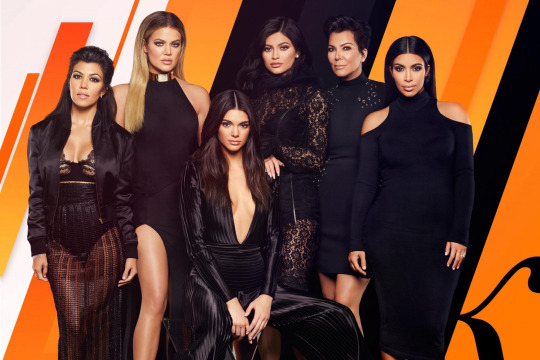
So, it turns out that people really dig reality TV because it gives them this feeling of realness and emotional ties 😭, even though a lot of what we see is totally staged, as per research (Frontiers, 2019). It's wild how this mix of real life and performance has turned people from just watching into getting involved. So, they're just hanging out online, sharing memes, and creating digital spaces for their favorite shows and celebrities.
In this post, we will discuss how the drama of Love Island and KUWTK draws our attention and how they shape societal norms and personal identities through reality TV.
Digital fandoms have really changed the game for reality TV, making it way more interactive and turning casual viewers into engaged participants. Shows like Love Island and KUWTK really get people talking, with fans breaking down every little moment on Twitter, Instagram, and TikTok. One dramatic recoupling or a hilarious Kardashian meme can totally kick off a ton of online buzz, GIFs, and things that go viral. So, Love Island totally nails it with hashtags and all that exciting stuff like
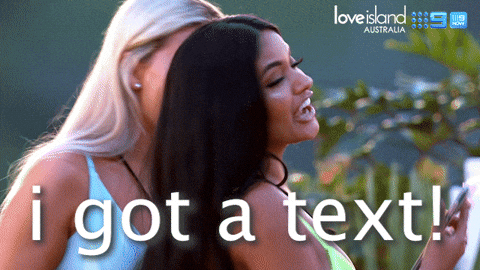
“I’ve got a text!”
to build a really engaged online community (BrandVision, 2024).
Some researchers label the show's engagement and viewership as "sousveillance." Its authenticity and production decisions are being critiqued as well as watched (L'Hoiry, 2021). Thus, the Kardashians master social media, employing it to maintain and build their celebrity brand (BrandVM, 2023). They skillfully blend real and fake photos online to show followers their lives.
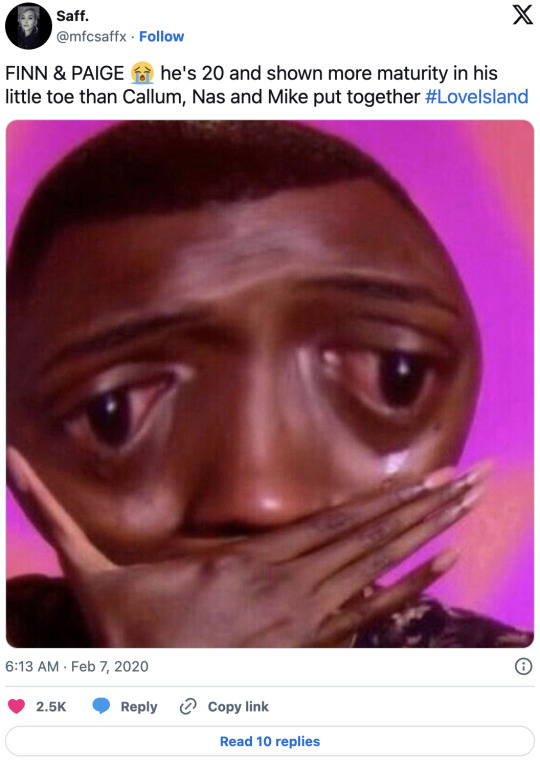
Digital fandoms have transformed how audiences engage with reality TV. Now, viewers aren't simply watching; they're contributing to the story.
KUWTK was more than just a show—it was all about the image. Flashy cars, fancy clothes, and big houses are now considered signs of success, influencing how young people view achievement. Zhao (2018) found that seeing curated luxury over and over can make people less empathetic towards those with less money and strengthen the idea that status and stuff are what really count.
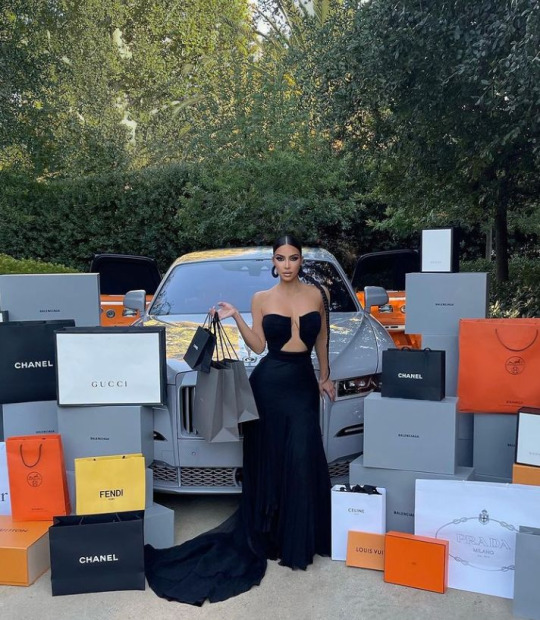
While many perceive reality TV solely as entertainment, it actually exerts a more significant influence than one might initially believe. With all the drama, luxury, and nonstop chatter online, shows like Love Island and KUWTK aren't just mirroring culture—they're influencing it.
And honestly, no matter how we feel about it, we’re all still tuning in.

References:
Frontiers in Sociology. (2019). Why reality TV feels real: Emotional engagement and performance. Frontiers in Sociology. https://www.frontiersin.org/journals/sociology/articles/10.3389/fsoc.2019.00059/full
Hallam. (2023). Love Island’s social media strategy. https://hallam.agency/blog/love-island-social-media-strategy/
L’Hoiry, X. (2021). Love Island, social media, and sousveillance: New pathways of challenging realism in reality TV. Frontiers in Sociology, 6, 1–9. https://doi.org/10.3389/fsoc.2021.644668
BrandVM. (2023). Love Island US and UK: How they engage audiences differently. https://www.brandvm.com/post/love-island-us-and-uk-engage-audiences
#MDA20009#RealityTV#LoveIsland#KUWTK#DigitalFandom#SocialMediaCulture#TumblrFandom#PopCulture#MediaStudies#RealityCheck#TVandSociety
0 notes
Text
Introduction & Disclaimer
Portions of this site and the works within it are being produced with the intention of critique and/or educational use under Australia's 'fair dealing' exceptions to copyright (Section 40 & 41). However, if you feel your IP is being infringed, please contact my service provider (Tumblr) with the appropriate DMCA requests, as I, the single author take full responsibility for the content of this site.
0 notes
Text
Mirror, Mirror on the screen: What is Body Dysmorphia & its effects?
Have you ever caught yourself scrolling Instagram or TikTok, liking others’ posts with glass-like, hourglass bodies, and then looked in the mirror thinking, “Why don’t I look like them?” In this age with filters and curated feeds, it’s easy to feel like everyone has their life together.
But… Here’s the Catch: Not all of them are real!
As we compare ourselves more, the more we risk falling into the trap of Body Dysmorphia Disorder (BDD)—a mental health condition where we are obsessed over perceived flaws that others might not even notice.
“If I just fix this one thing, I’ll look better.”

If this sounds familiar, don’t worry. You’re not alone.
BDD is a real mental health condition that deserves attention and care. It’s not just about how you look, but it’s about how you feel about how you look. This constant self-critique can spiral into anxiety, depression, and even self-harm. To cope, you might find yourself checking mirrors obsessively, excessively grooming, or avoiding social situations for temporary relief and often make things worse.
Platforms like Instagram, which emphasise looks, have been found to have more negative impact compared to other non-photo-based platforms. A recent study revealed that exposure to unattainable beauty standards through social media is associated with BDD among Egyptian medical students (Abdelaziz et al., 2025). Plus, studies have shown that with heavy use of social media, it links to negative gauging of one’s physical appearance, encouraging tendencies towards cosmetic surgery, especially among women (Frontiers, 2024). And it’s not just women feeling this pressure—men are also chasing the “ideal” muscular look that floods their feeds (Griffiths et al., 2018).

This isn’t just momentary; it’s a growing concern.
Moving forward.
Look, not all social media is about beauty standards. Tumblr? It’s one of the body-positive communities where people share authentic and unfiltered stories, supporting each other’s journey towards self-love. These spaces push back against the narrow standards common on other platforms, creating a place where people feel like they belong (Goldberg, 2021).
Honestly, who you follow matters. Surround yourself with accounts that promote authenticity and kindness instead of perfection. And remember the idea of body neutrality—focusing on what your body can do rather than how it looks. Focus on building a healthy, kinder relationship with yourself online (Poirier, 2021).

At the end of the day, your worth isn’t about how many likes or followers you have or how closely you match an ideal. It’s about feeling good in your own skin and supporting others to do the same. So next time when you scroll, ask yourself, is this making me feel good or not? Choose spaces that lift you up, and remember—you’re more than a filtered photo.

References:
Fardouly, J., Diedrichs, P. C., Vartanian, L. R., & Halliwell, E. (2024). Social media and body image concerns: Current research and future directions. Frontiers in Public Health, 12, Article 1324092. https://doi.org/10.3389/fpubh.2024.1324092
Abdelaziz, M. N., Moustafa, A. R. A., Azzam, H., et al. (2025). Association between beauty standards shaped by social media and body dysmorphia among Egyptian medical students. Scientific Reports, 15, 12976. https://doi.org/10.1038/s41598-025-95617-3
Friedman, L. (2024, March 15). Selfie culture is driving people to get plastic surgery so they look filtered. New York Post. https://nypost.com/2024/03/15/lifestyle/selfie-culture-is-driving-people-to-get-plastic-surgery-so-they-look-filtered/
Poirier, A. (2021, August 26). Why body neutrality works better than body positivity. Time. https://time.com/6279423/body-positivity-vs-neutrality/
Goldberg, A. (2021, January 19). What the return of 2014 Tumblr means for body image. Teen Vogue. https://www.teenvogue.com/story/what-the-return-of-2014-tumblr-means-for-body-image
#MDA20009#body dysmorphia#body posititivity#body image#body neutrality#self love#mental health awareness#tumblr community
1 note
·
View note